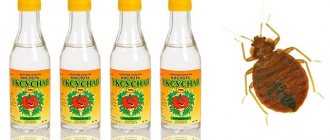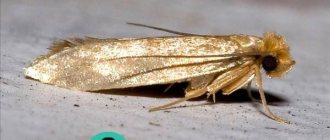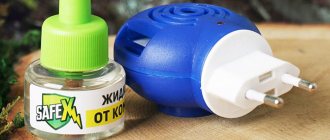Methods of protection
Preventing moths from appearing in your wardrobe requires some effort, but prevention is guaranteed to save valuable fur from the jaws of the pest. We suggest considering several methods that will tell you how to protect your fur coat from moths.
Separate wardrobe
As a rule, an insect that eats wool products ends up on a fur coat by accident. But since these parasites are quite unpretentious in food, they begin to spoil expensive fur with great joy.
Aerosols
Use aerosol insecticides. Today there is a fairly wide selection of such products and they are easy to find on the open market. The most popular and effective are:
- Raptor;
- Mosquitall;
- Antimol;
- Armol.
They are absolutely harmless to the fur coat, do not leave any traces and do not saturate the fur with their aroma (as a last resort, you can purchase an unscented product). These brands have specially developed fur protection products that are easy to use and highly effective. The aerosol must be sprayed from time to time on the inside surface of the closet and on the fur coat itself. The frequency of this procedure can be seen in the instructions that come with each drug.
Fumigators
Fumigators are also an excellent preventive measure. They are very easy to use and do not require any physical effort on your part. To place the fumigator in the cabinet, use an extension cord.
This product repels moths very effectively, and even if for some reason a butterfly gets into the wardrobe, the device will not give it the opportunity to reproduce and the insect will soon die.
Case
Use special covers for fur coats against moths. They are made in the form of thin cases and have a reasonable price. Adult butterflies and larvae are repelled by the aroma that permeates the inner surface of the case. In addition, they close very tightly, which prevents moths from getting inside.
The most popular and effective case is the one from the Raptor brand. When producing it, the manufacturer took into account all the peculiarities of the insect’s existence, and this cover perfectly repels both adults and caterpillars.
Advice! Fur products are usually sold in covers. Save them, this will be enough if you do not have the opportunity to purchase a special case.
Post-purchase inspection
It is very important to carefully inspect it before purchasing an expensive product, since even in elite salons the fur can be contaminated. Carefully examine the fur coat for thin, long tracks of trimmed fibers. When you arrive home, you must hang it on the balcony.
Advice! You can air the fur only in absolutely dry weather, and this can be either a warm sunny day or winter frost.
Even if moth larvae already live in a new fur product, direct sunlight or low temperatures are guaranteed to destroy them.
A few more tips:
Now you know which plant repels moths with its smell. Finally, remember a few important rules:
- Anti-moth plants should be used immediately, avoiding severe infestation of the room with butterflies;
- Change the products periodically - once the insect gets used to one scent, it will stop reacting to it. Remember, dry herbs retain their fragrant properties for 2-3 months;
- For an enhanced attack, use a whole collection of aromatic plants.
Where do moths come from in an apartment and how to get rid of them? This is interesting to know!
Symptoms of infection
Symptoms of moth infestation of a fur product are visible to the naked eye. The surface of the fur loses its attractiveness due to the formed lumps. Gradually, the paths and furrows eaten away by the larvae become clearly visible. The presence of pests is also indicated by the fur pile cut by them, as well as clearly visible “bald patches” on the surface of the fur product.
A moth in a fur coat does its dirty work catastrophically quickly, and any delay risks the fact that the fur coat will be irrevocably damaged.
The main enemies of fur
All fur pests can be divided into two categories: those that eat fur (fur, wool and furniture moths, carpet beetle larvae), and those that feed on the skin of the skin (meatfly, bread beetle). The damage caused to fur products by these insects is irreparable! “Bald patches” on furs, holes in the skin and “chewed” pile (fur moth) are very noticeable both on transverse mink coats or fox vests, and on muffs, hats made of sable, astrakhan fur.
Therefore, the main rule of a caring housewife is to prevent insects from appearing in the fur, because, despite the existence of effective measures to combat them, these procedures are quite labor-intensive and are not always safe for the product.
Actions to take if a fur product is contaminated
First, you should find out that it is a moth that has settled in your fur coat. Since the caterpillars of this insect are always hidden and are located at the base of the pile, it is quite difficult to notice them with the naked eye. Having settled in thick fur, they weave small silk cocoons, which are replaced after each molt. The food for them is the lint; they do not touch the skin.
Signs of infection
The main sign of moths in your fur coat is individual bald spots. Empty areas indicate that the infestation is still minor. What other symptoms might there be?
- The fibers stick out in different directions, the fur is crumpled and looks sloppy.
- Hairs accumulate on the floor under the fur coat, which the caterpillar has cut off in order to move to the neighboring area.
- In places where the larvae move, the fur is crushed.
The fur coat will be most damaged where the caterpillar crawled. To saturate it, it needs a small amount of lint, and when moving, it simply cuts off the hairs that are in its path.
The surest sign of fur infection is a large accumulation of butterflies in the wardrobe and caterpillars, which are already visible to the naked eye. In this case, it is necessary to take decisive steps to destroy them.
How to save the product?
Now it’s time to figure out what to do if your fur coat is eaten by a moth. Everything here will depend on the scale of the damage caused.
- If the damage is numerous, then, unfortunately, the fur coat cannot be saved and the expensive item will simply have to be thrown away.
- Small flaws and a small number of narrow “paths” can be painted over with a marker matched to the color of the pile.
- Sometimes it’s easier to dye the fur coat itself to match the color of your skin.
- One small bald spot can be hidden in a fold by cutting out the damaged area and stitching the skin from the inside.
- If the bald spot is large, but only one, then it can be hidden under a brooch or an original patch.
- If there is damage only on the hem, but you don’t want to throw away the fur coat, then you can shorten it by contacting a tailor.
How to quickly kill insects?
Modern powerful insecticides can provide a quick effect. They are guaranteed to remove moths at all stages of development from both the fur coat and the closet, without causing the slightest harm to the product itself.
Attention! Repellers and folk remedies do not give the desired effect. They are very good as preventative drugs, but nothing more.
The following aerosols will quickly destroy fur moths:
- Clean house;
- Antimol;
- Armol;
- Raptor;
- Extramit.
These products must be sprayed onto the fur coat, having first laid it out in a spacious room. The product should be processed from all sides, not forgetting about folds, pockets and lining material.
It is important to know! Fumigators are unable to quickly rid your home of moths, since their effect is very prolonged and takes about two weeks to destroy the parasites.
There are several more ways to quickly get rid of moths in a fur coat:
- take the product to dry cleaning;
- take the fur coat to the sanitary and epidemiological station, where it will be treated with heat;
- hang the fur item in the sun on a hot summer day;
- put the fur coat in a plastic bag, preferably black, and place it in the first seat of a car parked in direct sunlight;
- take clothes outside in severe frost (at least -10°C).
But these methods are not always effective, since in some cases the larvae can survive and continue to parasitize. Therefore, to achieve a positive result, the procedure must be repeated several times. In addition, it is worth paying attention not only to the closet with winter clothes, but to carry out a complete “cleansing” of the apartment from winged parasites. Special means will help with this, which we described in the article: The most effective remedies for clothes and food moths.
Fighting methods
One of the fastest ways to get rid of moths is disinfestation. There are now a lot of different aerosols in stores that quickly, without harm to the product and safely for humans, fight pests. These include Antimol, Raptor, Extramit, Clean House, Armol, etc.:
- Extramite: guarantees the death of insects a few hours after treatment. The effect lasts about six months.
- Raptor: the aerosol is suitable not only for combating existing moths, but also for prevention when storing fur coats. A single spray is sufficient for the desired effect. Does not spoil fur, including expensive ones. After killing the moth, it is advisable to spray the inside of the cabinets to prevent the parasite from reappearing.
- Clean House: to get rid of insects, you need to spray the entire apartment (especially cabinets, bedside tables, chests of drawers, where moths can appear). The products themselves do not need to be processed. You need to purchase the product at the rate of 1 cylinder per one-room apartment.
- Armol: a product with the aroma of lavender, which moths are so afraid of. Does not leave stains or other marks on the product. Suitable for getting rid of not only fur moths, but also clothing, wool and even food moths.
- Mosquitall: not suitable for all types of clothing, has a smell. Use in the same way as other aerosols.
To kill moths, you need to thoroughly spray the product on all sides, including in the folds, and also treat the cover (or a large plastic bag) from the inside, then place the fur coat in it and fasten it. Keep it this way for several days, during which it is advisable to additionally spray it with an aerosol inside the cover.
Aerosol Extramite
Aerosol Clean House
Aerosol Armol
Aerosol Raptor
If there are no special ones on hand at the right time, you can use other aerosols against crawling and flying parasites. But at the same time, you need to make sure that these preparations do not spoil the fur, leaving stains on it and a smell that does not disappear for a long time. Otherwise, the product can be taken to the dry cleaner, where it will be treated with heat, which will kill the moth, since it cannot tolerate high temperatures.
Fur coat cover
Among other means of control, you can use fumigators, but this will take time (about 2 weeks). In this case, the device must work in the cabinet itself, so you cannot do without an extension cord.
Sometimes special anti-moth sections are used against moths, but this product is good for repelling insects. It cannot destroy parasites, as it works on the basis of essential oils.
Among traditional methods, lavender essential oil or dried orange peels placed in cabinets are acceptable. But these means will not have a destructive effect either. They also mainly work only as a deterrent and are good as a preventive measure.
Why does it appear?
The reason moths appear in the house is that they feel truly comfortable here. The insect is completely satisfied with the air temperature, humidity, and most importantly, with a sufficient amount of a wide variety of food necessary for the fully formed caterpillar to make a cocoon for itself, turn into a butterfly and lay eggs.
Moths appear on fur coats and other fur products due to non-compliance with care rules. During wear, particles of sweat and dirt remain on the product - exactly what the moth larva needs for successful development.
Is it possible to save a moth-eaten fur coat?
If a moth has eaten a fur coat, then the possibility of saving an expensive item primarily depends on the degree of damage. For example, in the photo below you can see what a fur coat eaten by a moth looks like - if the moth has eaten the fur coat so badly, the clothes will either have to be thrown away or given to the homeless:
Review
“A moth ate my mink coat. It’s such a shame - we went to Greece for the whole summer, came back - and there were only rags hanging in the wardrobe. I gave my husband a fur hat and gloves. I don’t even know what to do. There were always records hanging in the closet, but they were of no use. I threw away my fur coat, my husband gave the hat to the watchman at work, and now I’m afraid to buy new fur so that nothing like this happens.”
Alena, Novosibirsk
If the moth has eaten only a small amount of the fur coat, having only managed to cut off a small area, then the area of damage can be painted over with a marker to match the color of the fur. Sometimes it is effective to repaint the entire fur coat to match the color of the skin itself. It is only important not to make “sudden movements” or try to radically change the color of the entire product.
If a small bald spot appears in one place, but the moth is successfully destroyed, you can carefully cut out the damaged area and stitch the skin from the inside. If there is minor damage, there will be no traces of the operation left on the surface of the fur coat. On a more serious scale, the bald spot will have to be covered with a brooch or design.
Finally, in some cases, even with serious damage, the damaged area can be simply cut out: make a sleeveless jacket out of a fur coat, for example, or cut off long skirts, simply shortening the product. However, for this it is better to use the services of an atelier.
Have you checked your mink coat in your closet lately?
Useful video: how to protect a fur coat and other things from moths
Hardened
If you haven't managed to dry your fur coat, the inner layer may harden, as in the photo. If the mink coat is wet and rough, you will need to rip the hem of the coat and try to soften the inside. To do this, you need special products designed to soften the skin. If you are confident that you can handle it on your own, then start this painstaking work. If you are not confident in yourself, then it is better to seek help from specialists.
It is necessary to prepare a special solution. In one liter of water at 20-22 degrees, dissolve salt - 1.5 tablespoons and vinegar essence - 2 tablespoons. Apply the prepared solution generously to the skin and leave for 30-40 minutes. Then we begin to gently knead the skin with our hands. This procedure should be done three times, taking a break of 2-3 hours. Now the fur coat needs to be allowed to dry thoroughly.
After washing
After washing, you suddenly discover that your favorite mink coat has shrunk. Most likely, the skins of your product were not of high quality. This defect is difficult to correct. Here you also need the help of professionals who, with the help of additional pieces of similar fur material, can increase the size of the fur coat.
Preparing fur coats for storage at home
- The product is sent for storage in its pure form.
- The fur coat must be thoroughly dried and brushed with a special fur brush. It is better to take a heavily soiled item to the dry cleaner.
- Before hanging in your wardrobe, you can leave it in the sun for a few days, if possible.
- Pests equally do not like high temperatures and frosts.
- It is best to store the product in a case and hang it on hangers of the appropriate size.
- Place moth repellents in the closet. Close wardrobe doors tightly.
Let's recognize the enemy by sight
Can food moths eat fur coats? No, for this type of insect the favorite type of food is dry cereals and dried dried fruits.
food moth
The food butterfly also differs from the clothes butterfly in appearance: it is larger in size and has a “disheveled” appearance due to the special structure of the wings.
Clothes moth
Having figured out what kind of moth is eating a fur coat, it is important to determine whether it is the culprit for the fact that bald spots and even holes have appeared on your favorite thing. The first signs of its presence include:
- loss of a presentable appearance by a fur item;
- the presence of short, as if cut, hairs in a storage case or in a closet;
- the appearance of unnatural folds in damaged areas;
- hair loss after touching the surface of the fur;
A fur coat or other product gives off a slightly unpleasant and persistent odor.
Natural fur coat
Where do food moths come from?
Finding food moths anywhere else, separately from food, is quite difficult, because they rarely fly and generally do not like to move, not to mention larvae. When the larva is ready to become a pupa, it crawls to the area under the ceiling, attaches itself there and turns into a full-fledged moth.
In general, food moths may well come from neighbors or crawl into an apartment completely by accident, but quite successfully. For example, you could bring it from the store after shopping, especially if the purchases were made at a market where cleanliness is not particularly monitored. If we talk about movements from neighbors or the outside world, then most likely it came through the ventilation ducts.
Protect woolen items from moths
Moths spoil not only mink coats, but also any items made of mouton and natural wool. After the summer season, you can find battered hats, scarves, sweaters and dresses, which also does not add optimism and joy. You can protect such clothes if you follow a few rules:
- Store things only in clean form. The smell of sweat and various stains are considered attractive to beetles. Before packing items, they must be washed or cleaned and dried thoroughly.
- Use sealed bags, preferably vacuum ones.
- Treat clothing and the inside of the package with a special spray before packaging.
- Place a tablet/wafer or bag of lavender inside the bag.
Prevention and rules for storing fur coats
Before you send your furry beauty into “summer hibernation,” you need to carefully prepare. This will prevent the appearance of pests.
To do this, it is recommended to carry out the following activities:
- Be sure to clean the product after the end of the season. Existing traces of wear are removed by dry cleaning.
- Fix any problems with the fittings. Carry out cosmetic repairs if necessary.
- Take care of a protective anti-moth cover, which will prevent parasites from getting to the treat. Don't skimp on this accessory. You can purchase covers soaked in essential oils, which moths really don’t like.
- To prevent pests from touching the fur product, create favorable storage conditions, ventilate the product from time to time, and let it breathe.
The second life of a moth-damaged fur coat
A moth has chewed on your fur coat, are you in despair, don’t know what to do with it? There is a way out of any situation, sometimes very simple, and sometimes expensive.
Before you get upset, evaluate the scale of your losses:
- If you notice minor stains on the collar, it may be enough to simply cover the flaw with a scarf or shawl.
- A chest island will hide a brooch of a suitable size, with a distracting effect.
- If the larva has damaged inconspicuous places, you can simply shade them with paint, a marker, shoe polish, just choose the tone.
- If you need to get rid of the affected areas on your fur coat, perform a small “operation”. To do this, cut out the infected areas and try to sew the incision. But first, make sure you can do it without being noticed.
- For severely damaged clothing, you may have to get creative. For example, make leather inserts, shorten the product, change the length of the sleeves, and so on. It is quite possible to recut the fur coat.
- What remains, on the one hand, is the easiest, and on the other hand, the most expensive option, when nothing can be done - buy a new fur item from a mouton or mink.
We showed a photo of what a fur coat looks like when eaten by moths, and told us how to prevent such a nuisance. Don’t let your favorite, perhaps your only, fur coat fall into disrepair. Consider the recommendations that will help you avoid the appearance and proliferation of moths in your wardrobe.
If it's already started
When a product is infested with moth parasites, this is clearly visible in the bald areas of the fur. However, there are less noticeable signs that should be identified in time to prevent damage to the entire fur:
- The fur coat begins to crumble slightly, lint accumulates at the bottom of the closet;
- On the affected area, the pile is directed in different directions, while all the fur lies in one direction;
- Crumpled fur in the path of larvae movement.
Potent insecticide aerosols will give excellent results in the fight against moths. Moth repellents for fur coats that will quickly and effectively help kill insects:
- Extramit;
- Antimol;
- Raptor;
- Clean house;
- Armol.
These preparations are sprayed over the entire surface, as shown in the video. In a well-ventilated area, lay the fur coat horizontally, treat it both outside and inside (from the lining side), including the pockets. After this manipulation, place the product in a case, also pre-treated with spray. Leave the mink coat in this position for a week, and then thoroughly ventilate it in the fresh air.
How to bring it into proper shape
When all measures to get rid of parasites have been taken, all that remains is to mask the flaws resulting from damage to the fur by moths in the following ways:
- Narrow bald spots can be easily painted with a felt-tip pen to match the fur;
- Have your entire fur coat repainted at the dry cleaners to match your skin color;
- If there are bald spots only at the bottom of the product, then you can cut off the hem, thus creating a short fur coat or sheepskin coat, and the item itself will be preserved;
- When the defects are in the area of the collar and shoulders, it is easily draped with a shawl, scarf or hidden under a huge brooch.
This article describes in detail recommendations on how to preserve a fur coat from moths. By using them for preventive purposes, your favorite mink coat will remain safe and sound for a long time. When a moth has done a little work on a fur item, certain actions will also help return it to its previous appearance.











